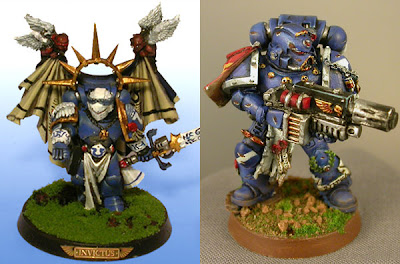ULTRAMARINES: Pay Attention
In a previous post I metioned how easily we can fall into the mantra of 'just get it done'. That was definitely my pitfall when it came to the Ultramarines. As my first army, I would work only to the minimum acceptable standard before moving onto the next model. Later I realized that in a tournament environment where painting matters, just putting down your 3 colors doesn't cut it. Ultimately this attitude cost me a major painting competition and several hundred dollars in prizes. There was plenty of effort, but it was misdirected. focusing on freehand details to cover up for a lackluster paintjob.The commander is well painted, but his paint scheme took the effort and style of a basic tactical marine. If I had been paying attention, I could have used extra colors and details to give such a great conversion a fitting paintjob.
In contrast, the Sternguard is painted with no conversions at all. I played with the standard Ultramarine blue, which I've found to be a dull color. With colored undertones and washes, I was able to reach a vivid blue with plenty of depth. I also paid attention to the details of the model, picking them out with contrasting colors. The result was a better looking marine painted in less time.
SPACE WOLVES: Break all the rules
Space Wolves is on the list of armies I would own if time and money were not a factor. I had been painting Wolves here and there for friends, but seeing my recently completed Wolf Guard side by side with the 13th Company marines I finished over a year ago pushed something to the forefront of my mind.
Breaking the rules is fun.
I painted an entire Eldar army using non-traditional shrine warrior colors, and it was great. The Universe is a big place, and there's plenty of room for those who prefer different colored armor. Space Wolves are notorious for ignoring protocol, opening the door even more to cut loose.
Painting the 13th Company was an exercise in repetition. I simply looked at the 'Eavy Metal color scheme, copying the formula as best I could. The mixed loyalist and chaos armor gave me some room to play, but otherwise I wasn't breaking any new ground.
However, when I went to paint the new plastic wolf guard models, my first thought was "What can I do to make this my own?" I worked the tribal color patterns into individual armor pieces to help the guard stand out. I wound up with a rowdy crew of individuals, and they looked it.
ORKS (orks orks orks): It's not the tool's fault
My camera is a 8 year old point and shoot Nikon. The laws of technology dictate that the same camera today would be 32 times better, and from what I can tell it is. But as I've learned, 95% of the time you are not being held back by your tools. Reading the manual was all I needed to take beautiful macro-scale pictures with what is considered an archaic piece of technology.
Lots of painters complain about their brushes. But the fact of the matter is that it probably isn't the brush that's causing trouble. I actually use cheaper brushes today than I did when I started. Properly cared for, even a $3 brush from a local craft store can produce beautiful results.
It all comes down to skill and education.
I was able to work extremely complex checker patterns and incredibly sharp gylphs with the same brush I've been using for half a year, still sharp as ever because I took the time to learn how to clean it properly.
But enough about what I've learned. What have you learned? How many of you have gone back to try out the old color schemes you started with? What is the one thing you would recommend to a beginner? I'm curious to hear your words of wisdom, so drop a line in the comments and let me know.


